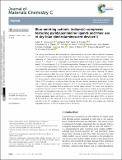Files in this item
Blue-emitting cationic iridium(III) complexes featuring pyridylpyrimidine cyclometalating ligands and their use in sky-blue and blue-green light-emitting electrochemical cells (LEECs) and organic light-emitting diodes (OLEDs)
Item metadata
| dc.contributor.author | Henwood, Adam Francis | |
| dc.contributor.author | Pal, Amlan Kumar | |
| dc.contributor.author | Cordes, David Bradford | |
| dc.contributor.author | Slawin, Alexandra Martha Zoya | |
| dc.contributor.author | Rees, Tomas W. | |
| dc.contributor.author | Momblona, Cristina | |
| dc.contributor.author | Babaei, Azin | |
| dc.contributor.author | Pertegás, Antonio | |
| dc.contributor.author | Orti, Enrique | |
| dc.contributor.author | Bolink, Henk J. | |
| dc.contributor.author | Baranoff, Etienne | |
| dc.contributor.author | Zysman-Colman, Eli | |
| dc.date.accessioned | 2017-10-16T15:30:12Z | |
| dc.date.available | 2017-10-16T15:30:12Z | |
| dc.date.issued | 2017-10-07 | |
| dc.identifier | 250951492 | |
| dc.identifier | ef6d8303-f293-4400-9040-cc37a34536da | |
| dc.identifier | 85030254023 | |
| dc.identifier | 000412069100015 | |
| dc.identifier.citation | Henwood , A F , Pal , A K , Cordes , D B , Slawin , A M Z , Rees , T W , Momblona , C , Babaei , A , Pertegás , A , Orti , E , Bolink , H J , Baranoff , E & Zysman-Colman , E 2017 , ' Blue-emitting cationic iridium(III) complexes featuring pyridylpyrimidine cyclometalating ligands and their use in sky-blue and blue-green light-emitting electrochemical cells (LEECs) and organic light-emitting diodes (OLEDs) ' , Journal of Materials Chemistry C , vol. 5 , no. 37 , pp. 9638-9650 . https://doi.org/10.1039/C7TC03110F | en |
| dc.identifier.issn | 2050-7526 | |
| dc.identifier.other | ORCID: /0000-0002-5366-9168/work/36661749 | |
| dc.identifier.other | ORCID: /0000-0001-7183-6022/work/56639092 | |
| dc.identifier.other | ORCID: /0000-0002-9527-6418/work/56861712 | |
| dc.identifier.other | ORCID: /0000-0002-5677-5070/work/59464927 | |
| dc.identifier.uri | https://hdl.handle.net/10023/11861 | |
| dc.description | EZ-C acknowledges the University of St Andrews for financial support. EZ-C and AKP thank EPSRC (EP/M02105X/1) for funding. The authors would like to thank the Engineering and Physical Sciences Research Council for financial support for Adam Henwood: EPSRC DTG Grants: EP/J500549/1; EP/K503162/1; EP/L505097/1 and the European Research Council (HetIridium, CIG-322280). The Valencian team acknowledges the financial support from the Spanish Ministry of Economy and Competitiveness (MINECO) via the Unidad de Excelencia Mara de Maeztu MDM-2015-0538 and MAT2014-55200, PCIN-2015-255 and the Generalitat Valenciana (Prome-teo/2016/135). C. M. thanks MINECO for her predoctoral contract. | en |
| dc.description.abstract | The synthesis, structural and photophysical characterisation of four novel, cationiciridium(III) complexes is reported. These complexes were designed to emit in the blue region of the visible spectrum, without employing sp2 carbon-fluorine bonds, which have been shownto be electrochemically unstable. Two different C^N (where C^N is a bidentate cyclometalating ligand possessing an nitrogen-carbon chelate) ligands [5-(4-methylpyridin-2-yl)-2,4-dimethoxypyrimidine (Mepypyrm) and 5-(5-(trifluoromethyl)pyridine-2-yl)-2,4-dimethoxypyrimidine (CF3pypyrm)] combine electron-withdrawing pyrimidyl nitrogen atoms (in a para relationship with respect to the metal) with methoxy groups in meta relationship with respect to the metal, which both inductively withdraw electron density from the metal centre,stabilizing the highest occupied molecular orbital. The result is highly efficient (φPL = 73 –81%) green to blue (λPL = 446 – 515 nm) emission for complexes 1 – 4 in MeCN solution.Complex 1 exhibits a broad, unstructured charge transfer (CT) emission profile, while complexes 2 – 4 exhibit structured, vibronic emission profiles. Density Functional Theory (DFT) calculations corroborate these findings, with spin density calculations predicting a T1 state that is metal-to-ligand and ligand-to-ligand (C^N to N^N) charge transfer (3MLCT/3LLCT) in nature for complex 1 , while complexes 2 – 4 are predicted to exhibit ligand-centred (3LC) states with spin density localised exclusively on the C^N ligands. These complexes were used as emitters in sky-blue and blue-green light-emitting electrochemical cells (LEECs). The bluest of these devices (CIE: 0.23, 0.39) is among the bluest reported for any iridium-based LEEC. Noteworthy is that although the electroluminescence intensity decreases rapidly with time (t1/2 = 0.1 – 20 min), as is typical of blue-green LEECs, for devices L1 , L3 and L4 we have observed for the first time that this decay occurs without an accompanying red-shift in the CIE coordinates over time, implying that the emitter does not undergo any chemical degradation processes in the non-doped zones of the device. | |
| dc.format.extent | 4114560 | |
| dc.language.iso | eng | |
| dc.relation.ispartof | Journal of Materials Chemistry C | en |
| dc.subject | QD Chemistry | en |
| dc.subject | QH301 Biology | en |
| dc.subject | DAS | en |
| dc.subject.lcc | QD | en |
| dc.subject.lcc | QH301 | en |
| dc.title | Blue-emitting cationic iridium(III) complexes featuring pyridylpyrimidine cyclometalating ligands and their use in sky-blue and blue-green light-emitting electrochemical cells (LEECs) and organic light-emitting diodes (OLEDs) | en |
| dc.type | Journal article | en |
| dc.contributor.sponsor | EPSRC | en |
| dc.contributor.institution | University of St Andrews. School of Chemistry | en |
| dc.contributor.institution | University of St Andrews. EaSTCHEM | en |
| dc.identifier.doi | https://doi.org/10.1039/C7TC03110F | |
| dc.description.status | Peer reviewed | en |
| dc.date.embargoedUntil | 2017-10-07 | |
| dc.identifier.grantnumber | EP/M02105X/1 | en |
This item appears in the following Collection(s)
Items in the St Andrews Research Repository are protected by copyright, with all rights reserved, unless otherwise indicated.

